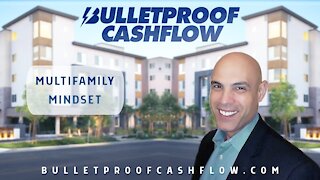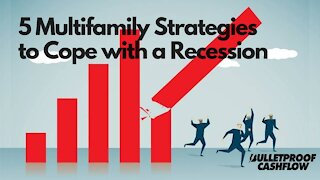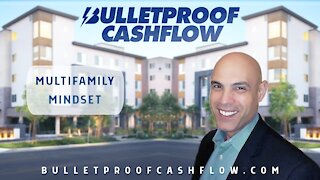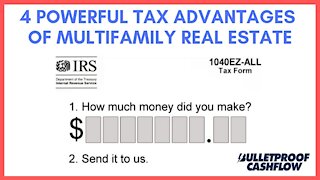Premium Only Content

What is Multifamily Syndication?
If you have seen my previous videos, you may already know that I got my start in real estate with single-family and small multifamily. When I wanted to kick it up to larger multifamily, I called up an attorney friend of mine who was very much into real estate and asked him how I would get started buying larger multifamily deals. He didn’t have much time on the phone and just told me “you syndicate the deal” and then he left. I didn't exactly know what he meant at the time, but I got to work, studied how to do multifamily syndication, and have done many deals since. Today, I will give you a high-level view of what syndication is and give you an opportunity to perform your own research.
Syndicating multifamily real estate is an evolution in income generating real estate for passive investors. Basically, you are partnering up with investors to buy an apartment building and cash flowing them afterwards via the tenant rents. While multifamily syndication has been around for a while, it has become more popular recently as a way for business professionals, doctors, and other W2 income earners to produce passive income while protecting their income from taxes. But before you begin syndicating your own deals or investing in them, you need to do the research and understand how it works and how it will make you and your investors money.
So, let’s define what a basic Multifamily Syndication looks like, but keep in mind that. there are many ways of structuring a deal. So this is a very high-level overview.
A deal syndicator puts together deals by first underwriting the property and then seeking out investors for the down payment capital needed to purchase the building. The General Partnership consists of the syndicator and any operating partners. The investors have a stake in the deal, like investing in shares, bonds or mutual funds, but are not involved in the day-to-day operations of the business. Returns are distributed first to the investors, and then to the General Partnership. Investors will have their risk tolerances and returns expectations. If you are the syndicator, you have to be sure to structure all this ahead of talking to your investors.
Risk tolerances vary on the building and what the plan is. If it is an older, class C property, there are primarily two types of projects the syndicator will be doing:
1. Distressed property: These properties have a low occupancy, 85% or less. A distressed property is an apartment building that is unstable, the maintenance is poor, and the operations are inefficient. There could be many problems with the building itself, such as a bad boiler or electrical problems. Typically, the tenants base is not very good as screening is poor.
2. Value-add property: These properties are more stable than the distressed ones. With occupancy greater than 85%, perhaps they have inefficient operations or poor maintenance and there is an opportunity to increase the value of the property. The main point about this kind of syndications is that it's generally economically viable due to the high occupancy rate. Banks typically like these deals.
In any case, the General Partnership should maintain transparent throughout the venture of any deal. Risks should be clear to all the investors; every deal has its own risks, no matter how good the offer looks. All this should be covered in the syndicators’ subscription agreement that is prepared by an SEC attorney.
I will be working on more training programs that will further explain the finer details of syndication. There is much more to it. The point is that for you guys and girls out there, there is indeed a way to buy larger multifamily. I have done it. You can do it too.
Are you wondering how to do or how to invest in your first deal? What would you like to see in a syndication training program? Let me know in comments.
If you learned something from this video, give it a thumbs up and check out our podcast Bulletproof Cashflow on iTunes or Stitcher, and subscribe to the new YouTube channel. We are working on getting new content out all the time to help you build your success in the world of multifamily.
Be great.
-
 13:02
13:02
bulletproofcashflow
3 years ago $0.01 earnedMultifamily Syndication: Basics Explained
72 -
 9:55
9:55
bulletproofcashflow
3 years agoWhat Makes Multifamily Recession-Resistant?
1051 -
 6:21
6:21
bulletproofcashflow
3 years agoWhat Happens to a Multifamily Property in a Downturn and How to Prepare for it
134 -
 4:48
4:48
bulletproofcashflow
3 years agoTHREE MUST DO Multifamily Renovations
176 -
 7:01
7:01
bulletproofcashflow
3 years ago $0.01 earned5 Multifamily Strategies to Cope with a Recession
261 -
 3:21
3:21
bulletproofcashflow
3 years ago $0.01 earnedLessons Learned from Multifamily Syndicator Interviews
48 -
 12:07
12:07
bulletproofcashflow
3 years agoA Guide to Multifamily Classifications (MUST SEE!)
47 -
 7:13
7:13
bulletproofcashflow
3 years agoReal Estate Syndication VS a Joint Venture
169 -
 2:36
2:36
bulletproofcashflow
3 years ago $0.02 earnedGetting Started in Multifamily Real Estate Investing
140 -
 7:31
7:31
bulletproofcashflow
3 years ago $0.01 earned4 Powerful Tax Advantages of Multifamily Real Estate
254